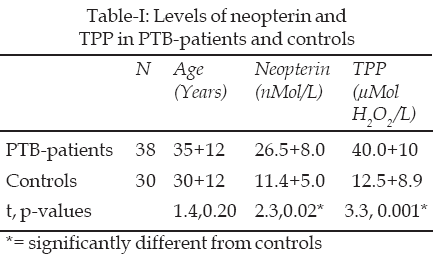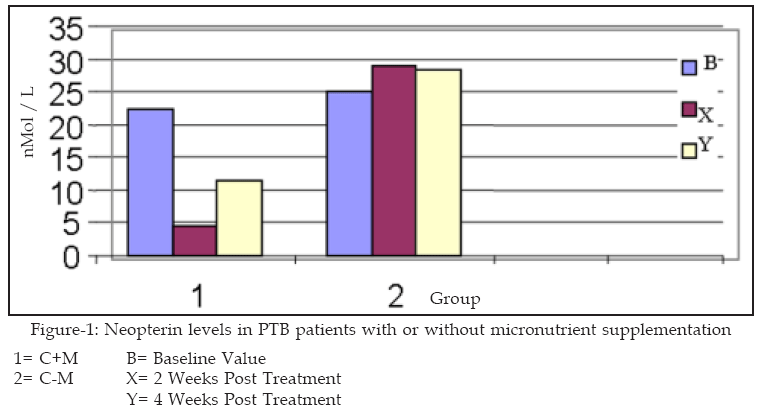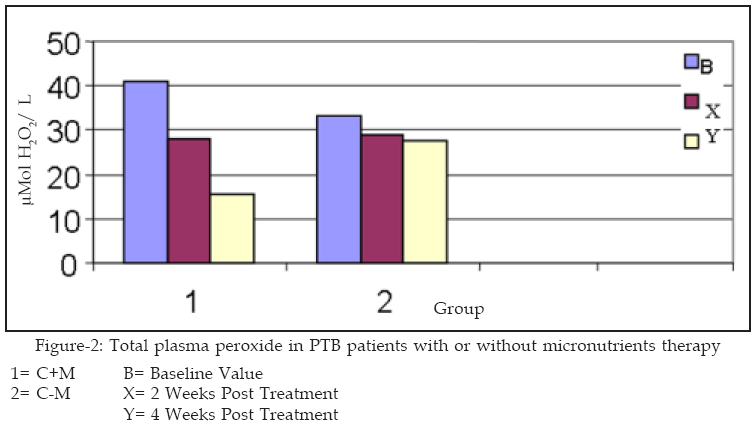|
|
||||
|
Published by : PROFESSIONAL MEDICAL PUBLICATIONS |
||||
|
ISSN 1681-715X |
||||
|
||||
|
- |
||||
|
ORIGINAL ARTICLE |
||||
|
- |
||||
|
Volume 25 |
April - June 2009 (Part-II) |
Number 3 |
||
|
|
||||
|
|
||||
|
|
||||
|
Published by : PROFESSIONAL MEDICAL PUBLICATIONS |
||||
|
ISSN 1681-715X |
||||
|
||||
|
- |
||||
|
ORIGINAL ARTICLE |
||||
|
- |
||||
|
Volume 25 |
April - June 2009 (Part-II) |
Number 3 |
||
|
|
||||
|
|
||||
Plasma neopterin and peroxide levels in pulmonary
tuberculosis patients on chemotherapy with or
without micronutrient supplementation
Akiibinu MO1, Arinola OG2, Ogunyemi EO3
ABSTRACT
Objectives: Neopterin and H2O2 are products of cellular (macrophage) activation. The exact roles of these secretions by activated macrophages in protection against tuberculosis remain unclear. In the present study, the changes in the levels of neopterin and total plasma peroxides (TPP) were assessed in pulmonary tuberculosis (PTB) patients on chemotherapy with (C+M) or without (C- M) micronutrient supplementation.
Methodology: Thirty-eight newly diagnosed PTB patients were selected for this study. Twenty patients were treated with anti-tuberculosis drugs and micronutrient (C+M) while 18 PTB-patients were treated with only anti-tuberculosis chemotherapy (C-M). Plasma neopterin and TPP concentrations were measured by enzymes linked immunosorbent assay (ELISA) and colorimetric method respectively.
Results: All PTB patients had elevated neopterin (p=0.02) and TPP (p=0.00) levels when compared with the non-PTB controls. Plasma level of neopterin and TPP declined significantly in C+M after 2 weeks of treatment (p= 0.00, p=0.01 respectively) and also after 4 weeks of treatment (p = 0.01 and p=0.00 respectively) when compared with baseline levels before treatment. No significant change was observed in the levels of neopterin and TPP in C-M after 4 weeks of treatment when compared with baseline value before treatment.
Conclusion: Micronutrient supplementation enhanced the decline in the levels of neopterin and TPP after two weeks of treatment. Chemotherapy alone did not produce significant reduction. Therefore, micronutrient supplementation of PTB drugs with synthetic antioxidants or naturally occurring ones (fruits and vegetables) should be attempted.
KEY WORDS: Pulmonary TB, Chemotherapy, Micronutrient supplementation.
Pak J Med Sci April - June 2009 (Part-II) Vol. 25 No. 3 380-385
How to cite this article:
Akiibinu MO, Arinola OG, Ogunyemi EO. Plasma neopterin and peroxide levels in pulmonary tuberculosis patients on chemotherapy with or without micronutrient supplementation. Pak J Med Sci 2009;25(3): 380-385.
1. Akiibinu MO,
2. Arinola OG,
2: College of Medicine,
University of Ibadan, Ibadan, Nigeria
3. Ogunyemi EO,
1,3: Department of Chemical Pathology and Immunology,
College of Health Sciences,
Olabisi Onabanjo University,
Ago-Iwoye, Ogun State,
Nigeria.
Correspondence
Dr. Akiibinu MO,
Department of Chemical Pathology and Immunology,
College of Health Sciences,
Olabisi Onabanjo University,
Ago-Iwoye, Ogun State,
Nigeria.
E-mail: akiibinumoses@yahoo.com
* Received for Publication: January 29, 2009
* Accepted: May 13, 2009
INTRODUCTION
Macrophage activation is an important feature of tuberculosis.
1 Tubercle bacilli invaded-macrophage undergoes transformation from a resting state to hyper-activated state with a characteristic feature of increased oxygen uptake, enlargement, increased number of organelles (mitochondria, lysosomes, ribosomes), total protein synthesis, rate and speed of phagocytosis.1,2 Other factors that enhance the transition from resting to hyper-activated macrophage are interferon gamma, mediators of inflammation and exogenous substances such as polyinosinic-cytidylic acid (poly 1ic). These functional changes in hyper-activated macrophages manifest itself in their ability to destroy the intracellular micro-organism (Tubercle bacilli). Whenever phagocytosis by activated macrophage fails, hydrogen peroxide (H2O2) is released. H2O2 is inhibited by the catalase in the extracellular space, but the macrophages prevent this catalase inhibition by forming a tightly-sealed pocket in the areas of contact with the particle.2 This H2O2 is therefore released continually by the macrophage with resultant high free radical load in PTB.3,4Neopterin, a pteridine derivative is also produced by the activated macrophage in response to the stimulation by the interferon-gamma.
1,5,6 Increased neopterin level has been reported in PTB, coronary artery disease, cancer5,7 and chronic vulnerable or disrupted atheromatous plague.5,8 However, neopterin has been suggested to play a pathogenic role in coronary artery disease while other studies described neopterin as a potential useful marker of both immune activation and coronary artery disease.7,9Micronutrients have been demonstrated to be potentially modulators of polymorphonuclear cells activities and macrophage activation.
10 Significantly lower levels of neopterin during anti-tuberculosis (anti-TB) therapy has been repoted.1,11 But none of these studies considered the possible synergistic effect of adjuvant micronutrient therapy on the neopterin metabolism during PTB treatment. This present study was designed to investigate the effect of micronutrient supplementation on the plasma levels of neopterin and Total Plasma Peroxide in PTB patients.METHODOLOGY
Thirty-eight newly diagnosed PTB patients and thirty non-PTB apparently healthy subjects volunteered to participate in this study. All PTB patients were sputum smear, Acid Fast Bacilli (AFB) positive with radiological examination showing pulmonary inflammation. They were negative to HIV-antibodies. Twenty of these PTB-patients were treated with micronutrient supplement and anti-TB chemotherapy (C+M) while eighteen PTB-patients were treated with only anti-TB drug (C-M). The non-PTB subjects were staffs of University College Hospital, Ibadan, Nigeria who were negative to HIV-antibodies and Mantoux test. None of this non-PTB had history of metabolic disorder, cardiovascular disease or liver disease.
The multivitamin supplement (FERRON 350) was produced by Savita Pharmaceuticals PVT. Ltd. Daman, India. Vitamin C tablets (100 mg) were purchased from Kunimed Pharmachem Ltd. Lagos, Nigeria. Each dose of the micronutrient supplement contained vitamin A (1600 i.u), vitamin E (5mg) vitamin C (100mg), Vitamin D (100i.u), Fe (5mg), Zn (0.5mg), Mg (3mg), Se (70 mcg), calcium(75mg), phosphorus(58mg), molybdenum (0.1mg), cholin (3mg), biotin(3mcg), vitamin B1 (1.0mg) vitamin B2 (1.0mg) vitamin B6 (0.5mg) vitamin B12 (0.5mg) once per day for a period of four weeks.
Five (5) milliliters of blood was withdrawn from each patient into a lithium heparin bottle on three occasions; (1) the day of recruitment of PTB patient (pre-treatment evaluation), (2) after two weeks and (3) after four weeks of treatment (post treatment evaluations). The blood samples were separately centrifuge at each collection and the plasma stored at -20
0C until analyzed.Measurement of total plasma peroxide concentration:
Total plasma peroxide concentration was determined using FOX 2 method12 with minor modification as stated in13 FOX 2 test system is based on oxidation of ferrous ion to ferric ion which reacts with peroxides in the plasma sample to produce a coloured ferric-xylenol orange complex which is measured spectrophotometrically at a wavelength of 560nm.Neopterin estimation: Neopterin estimation was carried out by using a solid phase immunoassay method as described by the manufacturer (IBL Hamburg, Germany, RE 59321). The test was based on a principle that when an unknown amount of antigen in the sample and a fixed amount of enzyme labeled antigen compete for the antibody-binding sites (rabbit anti-neopterin). Both antigen and antibody complex bind to the wells of the micro titer strips coated with a goat-anti-rabbit antibody. Unbound antigen is removed by washing. The intensity of the color developed (which is inversely proportional to the amount of antigen in the sample) was read using ELISA reader at 450 nm wavelength after adding the substrate.
Statistical Analysis:
The quantitative data were presented in the form of Mean and Standard deviation. Student (t) test was used for comparison between groups. Significance was considered when p-values are less than 0.05.RESULTS
All PTB patients (Table-I) had significantly higher levels of neopterin (26.5+8.0 nMol/L; p=0.02) and TPP (40.0+10 µMol H
2O2 /L; p=0.00) when compared with the non-PTB controls (12.4+10.0 nMol/L; 15.7+7.0 µMol H2O2 /L respectively).

As shown in Fig-1, neopterin levels declined significantly in C+M after 2 weeks of treatment (4.6+5.1 nMol/L; p=0.00) and after 4 weeks of treatment (11.5 + 11.1 nMol/L; p=0.01) when compared with baseline value before treatment (22.4+11.2 nMol/L). In C-M, there was no significant change in the value of neopterin after 2 weeks (29+8.0 nMol/L; p=0.26) and 4 weeks (28 + 4.0 nMol/L; p=0.38) of treatment when compared with baseline value (22.4+11.2 nMol/L) before treatment.

Also in figure 2, C+M showed significantly decreased levels of TPP at two weeks (27.9+10.5 µMol H2O2 /L; p=0.01) and four weeks (15.7 + 11.1 µMol H2O2 /L; p=0.00) when compared with the baseline value before treatment (40.9 + 31.0µMol H2O2 /L). C-M showed no significant change after 2 weeks (29.0+21 µMol H2O2 /L; p=0.59) and 4 weeks of treatment (28.0+16 µMol H2O2 /L; p=0.42) when compared with the baseline concentration before treatment (33.0+19 µMol H2O2 /L).

DISCUSSION
Increased production of reactive oxygen species (ROS) and reactive nitrogen intermediate (RNI) is a consequence of phagocyte respiratory burst during M.tuberculosis infection.
14 These products of activation are cytotoxic and need to be removed by efficient antioxidant system.15 Significantly reduced level of antioxidant activity has been reported in PTB by previous workers.1,16,17 The lower level of antioxidant activity was associated with excessive ROS, RNI production and oxidative stress in PTB.17 Increased oxidative burst is a characteristic feature of macrophage activation after M. tuberculosis invasion of the macrophage.2 Significantly higher level of TPP was observed in all our PTB patients before treatment. This significantly higher level of TPP in PTB-patients is consistent with earlier reports Kwiatkowska et al6 that high free radical load and increased level of peroxidation are futures of PTB. This level declined significantly after two weeks of micronutrient supplementation with anti-TB treatment (C+M). Anti-TB alone had no effect on the level of TPP in C-M after these four weeks of treatment. This report agrees with Plit et al,18 that plasma peroxide value is not affected by chemotherapy in PTB.The effects of micronutrients deficiency have been associated with antioxidants and immune dysfunctions in PTB.
17 Trace metals play important roles in the synthesis and catalytic activities of major antioxidant enzymes as well as in the bactericidal roles of polymorphonuclear cells.10 They may also regulate the status and bioavailability of other micronutrients and the antioxidant enzymes.19,20 Manganese, copper and zinc are an integral part of superoxide dismutase (SOD).10 Iron is an integral part of catalase, while selenium (Se) is an integral part of Se-GPX (glutathione peroxidase). SOD catalyses the conversion of toxic superoxide anion to less toxic hydrogen peroxide which is there after converted to water and oxygen in two separate reaction catalyzed by GPX and catalase (Maranujam.21 Catalase and glutathione peroxidase are major scavengers of H2O2, and this catalytic role makes them primary antioxidants.21 These antioxidant enzymes ultimately remove ROS from the system. The micronutrients included in the treatment of our PTB patients (C+M) could be responsible for the significant decline in TPP level either by directly scavenging the TPP by vitamins C and E or for the synthesis of micronutrients dependent antioxidant enzymes (superoxide dismutase, catalase and glutathione peroxidase).10,12The result of this study confirmed the previous reports that neopterin level is significantly higher in PTB. This higher neopterin concentration was also reported in TB co-infected HIV patients and in healthy health care workers, who had latent M. tuberculosis infections
1. High neopterin production is associated with increased production of ROS, and also a marker of the extent of oxidative stress elicited by the immune system.8 Chandra et al1 reported that TB stimulates the cellular activation which declined when the treatment was effective. This decline in neopterin level with treatment was also reported by several workers.22,23These previous reports showed decrease in neopterin levels when patients were treated with anti-TB for at least six months. The decrease in neopterin concentration was rapid in C+M. This result showed significant decrease in neopterin level in C+M after two weeks of treatment but no significant change was observed in C-M after four weeks of treatment in this study. Neopterin level is marker of macrophage activation and interferon gamma (IFN-d) activity which is dependent on the free radical load.
1,8 The significantly declined level of neopterin in this study may be attributed to the significantly reduced level of TPP in C+M within two weeks of treatment.In conclusion, micronutrient supplementation in the treatment of PTB reduces oxidative stress and lowers the level of neopterin. This study therefore suggests that adjuvant micronutrient therapy should be considered during PTB-patients’ management. Whether this will influence the overall effectiveness of chemotherapy need to be studied.
ACKNOWLEDGEMENT
Appreciations to Dr. Osho J A of Damien Foundation, Belgium, Nigeria Chapter and Mr. Akintola T O of Tuberculosis and Leprosy Unit, Oniyanrin Health Center, Ibadan, Nigeria, for allowing us to use their PTB patients for this study.
REFERENCES
1. Chandara I, Lalitha VK, Silambu C, Padmapriyadarsini C, Rehman F, Iliayas S, et al. Serum neopterin levels in HIV –infected patients with and without tuberculosis. Indian J Med Res 2005;121:220-5.
2. Klein J. In textbook of Immunology. Blackwell Scientific Publication, Oxford. 1989;331.
3. Wiid I. Seaman T. Hoal EG. Benade AJ. Van Helden PD. Total antioxidant levels are low during active TB and rise with anti-tuberculosis therapy. IUBMB Life 2004;56(2):101-6.
4. Halliwell B. Antioxidants and human disease: a general introduction. Nutrition Reviews 1997;55:44-52.
5. Murr C, Widner B, Wirleitner B, Fuchs D. Neopterin as a marker for immune system activation. Curr Drug Metab 2002;3:175-87.
6. Kwiatkowska S, Piasecka G., Zieba M, Piotrowski W, Nowak D. Respiratory Medicine 1999;93(4):272-6.
7. Avanzas P, Arroyo Espliguero R, Cosin-Sales J, Aldama G, Pizzi C, Quiles J, et al. Markers of inflammation and multiple complex stenoses (pan coronary plaque vulnerability) in patients with non-ST-segment elevation acute coronary syndrome. Heart 2004;90:847-52.
8. Apple FS, Wu AH, Mair J, Ravkilde J, Panteghini M, Tate J. Future Biomarkers for detection of Ischemia and risk stractification in acute coronary syndrome. Clin Chem 2005;51:810-24.
9. Ozmeric N, Baydar T, Bodur A, Engin AB, U Raz A, Eren K, et al. Levels of neopterin, a marker of immune cell activation in gingival crevicular fluid, saliva, and urine in patients with aggressive periodontitis. J Periodontol 2002;73(7):720-5.
10. El-Behairy F, El-Bassousy E, Diwany KW. Manual of Padiatrics. University Book Centre 1997;16.
11. Mohamed KH, Mobasher AAMT, Abdel-Rahim IY Adel S, El-Naggar IZ, Ghoneim HA, Richard WL. Bal neopterin. A novel marker for cell mediated immunity in patients with pulmonary tuberculosis and lung cancer. Chest 2001;119:776.
12. Miyazawa T. Determination of phospholipids hydroperoxides in human blood plasma by chemilluminescence-HPLC assay. Free Radical Biol Med 1989;7:209-17.
13. Harma M, Harma M, Enel O. Increased oxidative stress in patients with hydatidiform mole. Swiss Med Wkly 2003;133:563-6.
14. Evans C. Burdon R. Free radical lipid interactions and their pathological consequences. Prog. Lipid Res 1993;32;71-110.
15. Halliwell B. Gutteridge JC. Free radicals in Biology and medicine. 3rd edition oxford, Oxford Science Publications 1999.
16. Akiibinu MO, Arinola OG, Ogunlewe JO, Onih EA. Non enzymatic antioxidant status and nutritional profiles in newly diagnosed pulmonary tuberculosis patients in Nigeria. Afr J Biomedical Res 2007;10:223-8.
17. Arinola OG, Akiibinu MO. Plasma complement factor 1 (C1) and essential trace elements in children with protein energy malnutrition in Ibadan, Nigeria. Tropical J Health Sci 2008;15(2):16-19.
18. Plit ML, Theron AS, Fickl H, Van Rensburg CE, Pendel S. Anderson R. Influence of antimicrobial chemotherapy and smoking status on the plasma concentration of vitamin C; Vitamin E, beta-carotene, acute phase reactants, iron and lipid peroxides in patients with pulmonary tuberculosis. Intern J Tuberculosis & Lung Diseases 1998;2(7):590-6.
19. Sasaki Y, Yamagishi F, Yagi T, Mizutani F. A case of pulmonary tuberculosis with pan-cytopenia accompanied to bone marrow gelatinous transformation. Kekkaku 1999;74(4):361-4.
20. Anetor JI, Adelaja O, Adekunle AO. Serum micronutrient levels, nucleic acid metabolism and antioxidant defence in pregnant Nigerians: implications for fetal and maternal health. Afr J Med Sci 2003;32:257-62.
21. Goode HF, Puurkins L, Hearthy RV, Kelleher J. The effect of dietary vit. E deficiency on plasma zinc, and copper concentrations. Cli Nutr 1991;10:233-5.
22. Ramanujam MD. Free radicals and antioxidants – current status. www.meclindia.net/article/anitoxidants asp. 2004.
23. Guler M, Huddam D, UnsalE, Ciftci B, Bukan N, Erdogan Y, Capan N. The role of serum neoperin level in the evaluation of activation and response to treatment in the patients with pulmonary tuberculosis. Tuberk Toraks 2006;54(4):330-5.
24. Turgut T, Akbulut H, Devesi F, Kacar C, Muz MH. Serum interleukin-2- and neopterin levels as useful markers for treatment of active pulmonary tuberculosis. Tohoku J Experimental Medicine 2006;209(4):321-8.
HOME | SEARCH | CURRENT ISSUE | PAST ISSUES
Professional
Medical Publications
Room No. 522, 5th Floor, Panorama Centre
Building No. 2, P.O. Box 8766, Saddar, Karachi - Pakistan.
Phones : 5688791, 5689285 Fax : 5689860